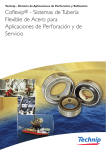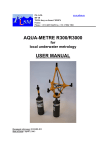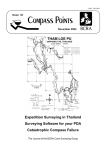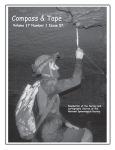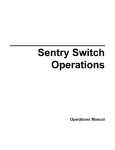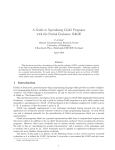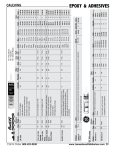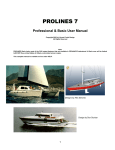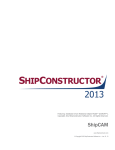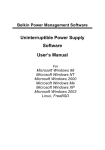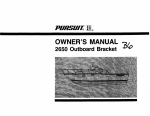Download AQUA-METRE D100 User Manual
Transcript
P.L.S.M. www.plsm-instrumentation.com 9, rue Charles DALLERY 78350 JOUY en JOSAS FRANCE AQUA-METRE D100 Version 2 USER MANUAL Contact: Telephone: +33 1 39 56 10 55/ fax : +33 1 39 56 10 93 Email technical questions: [email protected] Email general information: [email protected] P.L.S.M. ( www.plsm-instrumentation.com ) Manual overview This document constitutes the AQUA-METRE D100 Version 2 user manual (version of the system dedicated to light metrology operation for diver), it is organized in the following way: The chapter 1 is a general presentation of the AQUA-METRE D100. The basic monopointer system is described as well as the possible options completing this system. The chapter 2 describes the use of the system mono or multi-pointers since the preparation of the dive up to the measurements retrieval and the exploitation of the measures. The preparation and measurements retrieval software is also described along this chapter. The chapter 3 deals of the common maintenance of the system in particular the batteries charge. The chapter 4 is dedicated to system error and warning identification. The chapter 5 contains various technical information such as specifications and mechanical packaging description. In case of doubt do not hesitate to get in touch with your distributor either PLSM's support service ( [email protected] ). Distributor seal AQUA-METRE D100 User manual page 2 P/N 0100-900-106 P.L.S.M. ( www.plsm-instrumentation.com ) CONTENT 1. AQUA-METRE D100 Description ..............................................................................................6 1.1 AQUA-METRE D100.............................................................................................................6 1.1.1 Description of the Base and interferometric frame...............................................................8 1.1.2 Pointer, Pointer hydrophone with mini-mast and rod description.....................................11 1.1.3 The Pointer keyboard .............................................................................................................13 1.1.4 The infrared data link..............................................................................................................15 1.1.5 The PC based software..........................................................................................................16 1.1.5.1 Description.................................................................................................................16 1.1.5.2 Software installation and use ..................................................................................16 1.2 The system options .............................................................................................................18 1.2.1 Multi-Pointer option.................................................................................................................18 1.2.2 Surface Spy Pointer................................................................................................................19 1.2.3 Underwater composite mast..................................................................................................19 2. System set up ..........................................................................................................................20 2.1 2.2 2.3 2.4 2.5 2.6 2.7 3. Dive preparation..................................................................................................................20 2.1.1 « Dive preparation » function of the PC based software ...................................................20 2.1.2 Base preparation.....................................................................................................................21 2.1.3 Pointer preparation .................................................................................................................22 2.1.4 System check-up ....................................................................................................................24 Base mast set up ................................................................................................................25 2.2.1 Minimum and maximum depth..............................................................................................25 2.2.2 Acoustic path ...........................................................................................................................25 2.2.3 Accuracy vs. distance.............................................................................................................26 2.2.4 Operating area.........................................................................................................................26 2.2.5 Base stability and tilt ...............................................................................................................26 2.2.6 Noisy environment ..................................................................................................................27 Base activation....................................................................................................................28 Pointer use (diver operated mode)......................................................................................29 2.4.1 Rod installation........................................................................................................................29 2.4.2 Pointer switch on.....................................................................................................................29 2.4.3 The two submenus sets: « PARAMETERS » and « MEASURES »................................30 2.4.4 The « PARAMETERS » set of functions .............................................................................30 2.4.4.1 submenu #1: Zone choice .......................................................................................30 2.4.4.2 submenu #2: Dive parameters reporting ...............................................................30 2.4.4.3 submenu #3: Pointer address setting ....................................................................31 2.4.4.4 submenu #4: language choice ................................................................................31 2.4.4.5 submenu #5: backlight intensity..............................................................................31 2.4.4.6 submenu #6: receiver threshold tuning .................................................................32 2.4.4.7 « PARAMETERS » submenus summary ..............................................................33 2.4.5 The « MEASURES » mode ...................................................................................................34 2.4.5.1 submenu #1: coordinate measurement and storage ...........................................34 2.4.5.2 submenu #2: Base tracking.....................................................................................36 2.4.5.3 submenu #3: smart average setting.......................................................................36 2.4.5.4 submenu #4: Measurement spreading ..................................................................37 2.4.5.5 « MEASURES » submenus summary ...................................................................38 2.4.6 Pointer switch off.....................................................................................................................38 The Pointer Transponder mode (diverless operated) .........................................................39 System switch off ................................................................................................................40 Measurements retrieval and process..................................................................................41 2.7.1 Measurements retrieval..........................................................................................................41 2.7.2 Measurement process............................................................................................................43 Maintenance .............................................................................................................................45 3.1 Fresh water rinsing..............................................................................................................45 AQUA-METRE D100 User manual page 3 P/N 0100-900-106 P.L.S.M. ( www.plsm-instrumentation.com ) 3.2 3.3 3.4 3.5 4. Base Batteries Charge ........................................................................................................45 Pointer batteries charge ......................................................................................................46 Interferometric frame and Pointer hydrophone connector ..................................................46 Base or Pointer embedded software upgrade.....................................................................47 Troubleshooting ......................................................................................................................48 4.1 4.2 4.3 4.4 5. The Base does not switch on ..............................................................................................48 Underwater Base warning and error ...................................................................................48 The Pointer does not switch on...........................................................................................48 Pointer warning and error....................................................................................................48 Technical data..........................................................................................................................49 5.1 5.2 5.3 Specifications ......................................................................................................................49 Overall dimensions, weight .................................................................................................50 Recommended mast configuration .....................................................................................51 AQUA-METRE D100 User manual page 4 P/N 0100-900-106 P.L.S.M. ( www.plsm-instrumentation.com ) WARNING Although all the care were brought to the conception, the validation and the manufacture of the AQUA-METRE D100, by allowing notably a functioning in different sites as lakes and oceans, it is important to note that the implemented acoustic principles can be affected by particular rare conditions of propagation such as: strong local gradient of temperature (sharp thermocline), local variation of salinity and temperature (estuaries, resurgences of fresh water...). It is up to the user, in case of doubt, to control the consistence of the measures by using known shapes or reference points for instance (please contact PLSM for more information concerning the possible methods of validation). PLSM shall in no circumstances be responsible for any loss of use, loss of profits or any consequential loss of any kind suffered by the customer or any other party in any way connected with the use, nature or condition of the equipment. It is deeply recommended to read completely this manual before using the AQUAMETRE D100, any damage of the device consecutive to a bad use or to an error of the user can not be the object of an appeal in guarantee. THE AQUA-METRE D100 is not a safety system. It is the user responsibility to strictly respect safety regulations and legislation related to the professional or sport diving. The AQUA-METRE may affect echo sounders accuracy due to acoustic interference. Do not rely on echo sounder indications when using the AQUA-METRE 200 metres away or less from the boat. AQUA-METRE D100 User manual page 5 P/N 0100-900-106 P.L.S.M. ( www.plsm-instrumentation.com ) 1. AQUA-METRE D100 Description 1.1 AQUA-METRE D100 The AQUA-METRE D100 is a local underwater positioning system based on an acoustical interferometric scheme (mainly known as Ultra Short Base Line or USBL). It is particularly well suited to accurate local 3D locating within a range of up to 150 metres from the reference point. This is a user friendly, full stand-alone system, free of bottom to surface cables and can be operated by a single unspecialised diver without hard training. Measurement set up and retrieve are performed using standard PC based software and an infrared data link, DXF file format output allows direct link to CAD tools. Self-calibration during power-up allows water celerity measurement (without any operator intervention). The AQUA-METRE D100 is made of two main components: -The measurement Base, which constitutes the reference Cartesian coordinate system {0,0,0}), at the top of a 2 metres (6 feet) mast. This mast remains underwater during the whole measurement operation. -A light portable Pointer, which includes a small keyboard and LCD display panel, allows the diver to measure positions and save them in the back-up memory. One Base can work with up to 8 Pointers simultaneously (8 divers or ROV transponder or spy pointer, see options description after). Each pointer can be fitted with a rod that allows measurement offset from sea bottom (the rod length and orientation are compensated internally using inclinometers and compass). On return to the surface, the pointer is downloaded via a standard PC computer station equipped with infrared serial data link and batteries can be charged using classic AC-AC transformer (infrared adapter module and batteries charger are included in the basic package). AQUA-METRE D100 Basic single diver configuration AQUA-METRE D100 User manual page 6 P/N 0100-900-106 P.L.S.M. ( www.plsm-instrumentation.com ) interferometric frame Transport case Pointer Basic rod screw Hydrophone with minimast Base Charger Infrared interface AQUA-METRE D100 Version 2, mono-pointer system version When the system is delivered, please check the package, it must include: Designation Base Interferometric frame Pointer Pointer Hydrophone with mini-mast Basic rod for pointer Pellican 1620 transport case Batteries charger (for Base or Pointer) Software to interface the system (CDROM for PC) Infrared interface module User manual Screw (note 1) Quantity 1 1 1 1 1 1 2 1 Part Number 0100-100-xxx 0100-400-xxx 0100-200-xxx 0100-270-xxx 0100-700-xxx 0100-600-xxx 0100-500-xxx 0100-800-xxx 1 1 0100-300-xxx 0100-900-xxx 0100-171-xxx 2 (note 1) : two screws are provided, one for spare AQUA-METRE D100 User manual page 7 P/N 0100-900-106 P.L.S.M. ( www.plsm-instrumentation.com ) 1.1.1 Description of the Base and interferometric frame The Base and the associated interferometric frame are the main components of the system. This is the Base that interrogates the pointer(s), calculates the coordinate, using an interferometric measurement scheme, and sends it back to the pointer(s) through the acoustic data link. The base: The Base is made of the housing (1), the mast head (2) with the fast locking system (3), and the interferometric frame socket (4). The housing also includes an infrared windows (5) to allow communication with the PC during the survey preparation (refer to chapter «The infrared data link between the PC and the Base/pointer »). 3 4 5 2 1 5 2 1 3 9 On the top of the housing, one can find the main contactor (6), to switch the Base on or off, the batteries charge connectors (7), the Base status led indicator (8) and the interferometric frame female connector socket (9). 6 8 7 1a 2 The interferometric frame: The interferometric frame is a very strong structure that fits the four hydrophones (1a to 1d) used for the measurement. The top hydrophone is the origin of the local coordinate system {0,0,0}. A plastic screw (2) is used to lock the interferometric frame on top of the mast head (3). To ensure the proper clocking between the mast and the interferometric frame, the pin press fitted in the mast head must be installed in the locating hole roper angular locking when installed in the dedicated locating hole (4) on the frame foot. AQUA-METRE D100 User manual page 8 1d 3 4 1b 1c P/N 0100-900-106 P.L.S.M. ( www.plsm-instrumentation.com ) The local Cartesian coordinate system is associated to interferometric frame. A biaxial inclinometer allow correction of mast inclination up to +/-10° in order to always compute coordinate in a coordinate system where the Z axis is vertical and X and Y axis horizontal. The origin of the system is the top hydrophone. The picture below shows the coordinate system associated with the interferometric frame: θ A point M is given by : M Z -the distance d from the origin, d -the azimuth angle φ in the horizontal plane, -the elevation angle θ from vertical. (Spherical coordinate system) Y {0,0,0} X φ Pin hole this side Local coordinate system associated to the interferometric frame Warning : The precise geometry of the interferometric frame guarantees the accuracy of the system. It is very important to keep frame protection installed until switch on underwater and to replace it when switching the Base off. Any deformation of the frame may affect the accuracy. If you have any doubt after a frame hurt, please contact PLSM or your local distributor for checking. AQUA-METRE D100 User manual page 9 P/N 0100-900-106 P.L.S.M. ( www.plsm-instrumentation.com ) Interferometric frame and Base assembly: Place the frame foot over the mast head (A), and turn it until the locating pin is aligned with its locating hole, then lock with the main screw (B). guidage Check that the frame is properly installed by looking for clearance. Any clearance in this area may be detrimental for the measurement accuracy. A Then plug the electrical male connector on the female socket located on the base housing (full proof design). B C Warning : Before plugging the electrical connector, make sure that no dust nor any solid particles can be entrapped inside the female or male parts. The use of silicon spray oil is recommended for the proper contact (refer to chapter 3: maintenance). Then finally, screw the sleeve over the connector to secure it ( C ). AQUA-METRE D100 User manual page 10 P/N 0100-900-106 P.L.S.M. ( www.plsm-instrumentation.com ) 1.1.2 Pointer, Pointer hydrophone with mini-mast and rod description The Pointer: The Pointer is made of a cylindrical mechanical housing including a transparent window that covers the liquid crystal display (LCD) (1), the infrared interface window (2) and the red/green indicator (3). The Pointer also includes an underwater keyboard (4) with five main keys a special function key (5 - only used on surface). The top cover support the hydrophone connector protected by a plastic part with a thread for the Pointer hydrophone with minimast mounting and connector (6). 6 4 1 2 5 3 7 The bottom side of the Pointer includes a large thread for the rod mounting (7) and the charge connectors (8). 8 The Pointer hydrophone with mini-mast: The Pointer hydrophone is offset from the Pointer housing to avoid acoustic reflection and direct diver regulator noise close to the hydrophone. The hydrophone is plugged into the Pointer top connector and maintained by the mini-mast which is screwed using the top thread Pointer & mini-mast Connect the hydrophone first Pointer with hydrophone & minimast AQUA-METRE D100 User manual page 11 P/N 0100-900-106 P.L.S.M. ( www.plsm-instrumentation.com ) The rod and the attachment to the Pointer: The main function of the rod is to offset the Pointer hydrophone from the surface in order to avoid acoustic path mask and to limit the influence of reflection. The Pointer includes a fluxgate compass and a biaxial inclinometer in order to compensate the 3D rod offset. Thus, measurement always refers to the rod extremity. The size and 3D shape of the rod is a parameter of the system, user can define them when preparing the dive with the PC software. A simple vertical rod is part of the basic delivery, but one can use « L » rod for measurement along vertical wall (dam,… ) or « J » rod for measurement on underwater roof. The rod geometry is defined along the menu « Dive preparation » of the PC based software. Default setting is a simple vertical rod (length 1.685 meter including 1.04 rod length plus 0.645 meter Pointer and mini-mast length). Warning : The rod compensation introduces an error not negligible when the Pointer inclination exceed 15°, during underwater measurement, a small pictogram give an indication of the inclination of the Pointer in both axis (refer also to chapter 2.4.5.1), this indication eases the diver to operate the system well. AQUA-METRE D100 User manual page 12 P/N 0100-900-106 P.L.S.M. ( www.plsm-instrumentation.com ) 1.1.3 The Pointer keyboard The Pointer is equipped with a custom keyboard able to operate underwater (salt or fresh water) and also on surface. This keyboard is specially design to withstand harsh conditions and to be easy to clean. It has no moving part but only stainless steel keys. There are five keys (respectively « Esc », « Meas », « Param », « -/Dec » and « +/Incr ») plus a special key« Com » for surface mode. Special key « com » The Pointer keyboard with the special key « Com » Underwater use: when underwater, the keys are simply activated by covering them with a finger (the way it works is mainly a detection of an insulation from water conductivity). Surface use: on surface, each key is activated by covering it with a finger and also the special key « com » with another finger of the same hand. It is better to get wet fingers when trying to activate a key on surface. Activation of the key « +/Incr » on surface AQUA-METRE D100 User manual page 13 P/N 0100-900-106 P.L.S.M. ( www.plsm-instrumentation.com ) Tips : -when a key is successfully activated, the green light flash for few hundred of milliseconds, -when switched on, the keyboard is automatically calibrated in order to operate in the ambient field (salt or fresh water or surface,… .), keep it free of finger up to the switch on confirmation in order to make the calibration easier, -when the Pointer goes from sea water to surface or surface to sea water, user may have to wait up to ten seconds for the new keyboard calibration. (Warning: User has to switch the Pointer on underwater to be able to make measurement). -when using the Pointer on surface, keep the keyboard dry and clean, -a new keyboard calibration occurs every five seconds, keep it free when no key activation is desired, -in case of keyboard malfunction, the Pointer will automatically switch off (after data storage), then, try to switch it on again (if the error occurs again, please contact your distributor or PLSM, [email protected]). AQUA-METRE D100 User manual page 14 P/N 0100-900-106 P.L.S.M. ( www.plsm-instrumentation.com ) 1.1.4 The infrared data link The AQUA-METRE is delivered with a serial port (9 pins) to infrared interface module. In order to communicate when working with the PC based software, the window of the infrared module has to be placed in front of the Pointer or Base infrared window (when working with the Pointer, please place the Base out of infrared field). The distance between the module and the Pointer or the Base (depending which is in use) has to range from few centimetres up to one meter. Make sure that infrared windows are in front of each other as shown below (Pointer or Base): 30 to 60 cm Pointer in font of the module Infrared interface module with the connector 30 to 60 cm Base window in front of the module AQUA-METRE D100 User manual page 15 P/N 0100-900-106 P.L.S.M. ( www.plsm-instrumentation.com ) 1.1.5 The PC based software 1.1.5.1 Description This software allows: - to prepare the Pointer(s) and base for measurements by defining the parameters like Zone names (refer to chapter 2.1 « Dive preparation »), - to retrieve the measurements from the Pointer(s) and export them to CAD software (refer to chapter 2.7 « Data retrieval and processing »), This software must be installed on a PC running at least Microsoft WINDOWS 95 operating system. Communication with the Pointer or the Base uses an infrared data link. The infrared interface to the PC is provided with the system and must be connected through a serial communication port (RS232) of the PC. Only one device can be addressed in the same time by the software (please put the other device at least five meters away from the infrared path). 1.1.5.2 Software installation and use To install the software, insert the CDROM and run the setup.exe file, then follow the directives (to choose the target path… ). In case of doubt or trouble when installing the software, feel free to contact PLSM or your distributor. When the installation is finished and successful, the software can be started and the following window appears: Main window of the PC based software (picture from the marine encyclopedia of Diderot-D’Alembert) AQUA-METRE D100 User manual page 16 P/N 0100-900-106 P.L.S.M. ( www.plsm-instrumentation.com ) The scroll menu «Measures » gives access to menus: « Preparation » and « Measurements retrieval » described in chapter 2. The menu “Data processing”allows exporting the measurement text file to CAD software using the .dxf format (from Autodesk). The « Options » scroll menu gives access to software parameters setting like Communication port choice (COM1 to COM4) or language (French or English). The following diagram describes the different steps when using the AQUA-METRE, the green steps are those requiring the PC based software: Dive preparation Dive, measurements Measurements retrieval Export to CAD format (.dxf,… ) Measurement process (CAD software,… ) Different steps when using the AQUA-METRE D100 To get more details about the PC based software use, please refer to chapter 2. AQUA-METRE D100 User manual page 17 P/N 0100-900-106 P.L.S.M. ( www.plsm-instrumentation.com ) 1.2 The system options 1.2.1 Multi-Pointer option The basic system uses only one Pointer simultaneously with the Base. The main system option consists of a Base embedded software upgrade that allows the Base to manage up to 8 Pointers simultaneously;each Pointer is associated with a logic address between 1 and 31. When using a multi-pointers Base software, every Pointer are interrogated sequentially according the Pointer(s) list programmed in the Base parameters. Thus, the measurement rate decreases when the number of Pointers increases (from 2 seconds per measurement up to about 10 seconds per measurement with 8 active Pointers). A basic single Pointer system can be upgraded to a multi-Pointers system (please contact PLSM or your distributor if you need it). Multi-pointers configuration The PC based software can work with a single or multi-Pointers system, but only a multiPointers Base version will accept to be programmed with a list of Pointers. AQUA-METRE D100 User manual page 18 P/N 0100-900-106 P.L.S.M. ( www.plsm-instrumentation.com ) 1.2.2 Surface Spy Pointer In some case, it may be interesting to monitor the underwater activity from the surface. To do that, PLSM offers the “Spy”Pointer that acts at least as a normal Pointer but having the hydrophone connected with a 10 meters length cable. Moreover, this Pointer is able to sniff the underwater messages broadcast from the Base to the active(s) Pointer(s) and to report them on a serial interface to a PC (by using NMEA type like text message). Spy Pointer Important: the Spy Pointer can be used only with a multiple-pointers Base embedded software version. The Pointer can also be used on ROV. In this case a special Pointer mode called simple Transponder mode can be activated and data are collected using the Spy Pointer. 1.2.3 Underwater composite mast The complete mast and the ballast are not part of the basic system supplies. A concrete ballast sketch, that requires no specific skill for building is proposed on chapter 5. The mast may be manufactured by the user or provided by PLSM. In this case, it consists of a two-meter high tube made of composite material, fully adapted to the base installation. AQUA-METRE D100 User manual page 19 P/N 0100-900-106 P.L.S.M. ( www.plsm-instrumentation.com ) 2. System set up 2.1 Dive preparation 2.1.1 « Dive preparation » function of the PC based software To run this function, start the software and choose the scroll menu « Measures/Dive preparation », the following windows appears: « Dive preparation » windows Into the right frame are located all parameters related to the Base: addresses of all desired active Pointer(s) (only a multi-Pointers Base version will accept more than one Pointer). Refer to chapter 2.1.2 for details concerning the Base preparation. The left frame includes the parameters related to the current Pointer edited (the one which number’ s colour is red in the right frame). Refer to chapter 2.1.3 for details concerning the Pointer(s) preparation. AQUA-METRE D100 User manual page 20 P/N 0100-900-106 P.L.S.M. ( www.plsm-instrumentation.com ) 2.1.2 Base preparation The Base preparation only includes the definition of the Pointer(s) list and has to be done only when a new Pointer is introduced in the field (or removed). In case of a single Pointer system, there is no need for Base preparation since only one Pointer will be interrogated with default address #05. a) connect the infrared module to the PC, run the software, b) place the module window in front of the infrared Base window (according the picture on the right), 30 to 60 cm choose the scroll menu « Measures/Dive preparation », the following window appears: Active Pointer switches Pointers Address Dive preparation window To define the Pointer(s) list, check the Active Pointers select box, and when checked, do not forget to give a valid address in the Address text box (the Pointer address is a number between 1 and 31). The first Pointer is obviously always active (there must be at least one Pointer to operate the system!). Warning : - only a multiple-Pointers Base version will accept a list including more than one Pointer, - make sure that two different Pointers do not share the same address. Once the parameters are defined, click the « Program Base » button, a message will then ask the user to switch the Base on. When the Base download is finished, a message will inform the user if it is successful or not. This Base preparation is necessary only if the Pointer(s) list changes. AQUA-METRE D100 User manual page 21 P/N 0100-900-106 P.L.S.M. ( www.plsm-instrumentation.com ) 2.1.3 Pointer preparation It is better to store the measurements in different memory location according the item they refer to. Imagine for instance that a car has to be surveyed underwater, then, it is smarter if user can define measurement collection names like « wheels », « doors », « windows » and so on, in order to facilitate the data processing when transferring them to a CAD software. This function is available with the Pointer, they are called “Zone name”and may be defined during the Pointer preparation To define these zone names, operate as follow: a) connect the infrared module to the PC, run the software, b) start the Pointer with two wet fingers (« +/Inc » and « com » keys and confirmation), see picture on the right: 30 to 60 cm place the module window in front of the infrared Pointer window (according the picture on the left), choose the scroll menu « Measures/Dive preparation », the following window appears: Edit window Pointer address Zones list Current edited Pointer Rod definition Dive preparation window AQUA-METRE D100 User manual page 22 P/N 0100-900-106 P.L.S.M. ( www.plsm-instrumentation.com ) The choice of the Pointer to be edited is made using the select Pointer switches, the number of the selected Pointer is displayed in red colour. With a single-Pointer version of the Base, only one Pointer (#01) may be edited, it is recommended in this case to avoid changing his address (anyway make sure that the Base and Pointer share the same address). The upper left frame includes the Zone names definition boxes (default setting is Zone n°01 to Zone n°50). To edit a Zone name, just click it in the list, it appears then in the modification box where you can edit it. It is also possible to remove one or all Zone names (by using the buttons « Remove » or « Remove all » respectively). It is also possible to add a Zone name using the button “Add”. User can save or read the list of Zone names by using the menu « File/Save as » or « File/Open». These files are text ASCII files with the extension .pre.(for preparation). When the Zone names are defined, set the parameter of the rod by filling the rod geometry definition boxes. Default setting is for the simple vertical rod. The rod geometry is described on the product identification label. The estimation of the geographic location of the survey site must also be entered like for the Base preparation (see previous chapter dedicated to Base preparation). When all parameters of the current Pointer are settled, then click the « Program Pointer » button. When the download is finished, you can exit the window by clicking the « Quit » button. It is recommended to check the Pointer setting by switching it on and using the Pointer keyboard to check the Zone names. When using several Pointers, just cycle this procedure with all Pointers. Warning: when you add or remove a Pointer from the active Pointer list, do not forget to reprogram the Base with the new list. Special Transponder Mode: The “Transponder mode”check box allows activation of a specific Pointer mode. This mode may be activated when user want to make the Pointer automatically reply to Base interrogation without diver need, this is the case of ROV tracking for instance. When this mode is activated, the Pointer directly enters the reply mode after switch on (always using the keyboard) and a specific key sequence is needed to switch it off to avoid This specific Pointer mode is detailed in chapter 2.5. To activate this mode, just check the box and click the « Program Pointer » button. A confirmation message will be displayed after Pointer connection. Transponder mode Check Box AQUA-METRE D100 User manual page 23 P/N 0100-900-106 P.L.S.M. ( www.plsm-instrumentation.com ) 2.1.4 System check-up Before the dive, check the batteries charge status (see chapter 3) and the overall state of the system. If the housings are hurt, it may affect the watertightness. In case of doubt, please contact PLSM or you distributor (before delivery, all parts of the system are proofed to a pressure equivalent to 100 meters deep, or 10 bars). Field test procedure: It is possible to simply check the system. Switch the Base on and immerge it immediately at 50 cm (at least), you can hang it with a cable. Wait for at least 1 minute and switch the Pointer on underwater at 10 cm (just hand it). After the self-tests procedure, the Pointer will display incoming coordinates or just a warning message that indicates the over range inclination of the Base. AQUA-METRE D100 User manual page 24 P/N 0100-900-106 P.L.S.M. ( www.plsm-instrumentation.com ) 2.2 Base mast set up 2.2.1 Minimum and maximum depth The system required at least 5 meters depth to operate well. In this case, the interferometric frame must be set up at mid depth (i.e. 2.5 meters). 2.5 meters minimum If operated in no more than 5 meters deep, the accuracy may be affected by severe multipath environment when distance from Base to Pointer exceeds 30 meters. To operate well up to 100 meters, the system requires at least 10/15 meters deep. BASE 2.5 meters minimum 1 meter minimum (simple rod) When measuring coordinates near seafloor, make sure that the Pointer is operated with a minimum vertical offset rod of 1 meter. Maximum operating depth is 80 meters (system with extended operating depth on demand, please contact PLSM). In shallow water, typically less than 10 meters, the acoustic data link may be affected by severe multipath environment leading to demodulation error. The message ‘ Noise”will be then display more often than in deeper condition, reducing also the measurement speed. 2.2.2 Acoustic path To operate, the AQUA-METRE D100 requires a direct acoustic path between the Base and the Pointer (this is an advantage compared to long baselines system which requires several paths). A mask may affect the accuracy and/or stability of the measures, or may simply make acoustic wave vanish. The following rule must be followed: keep at least one meter clear from the direct virtual line between the Base and the Pointer as described below: BASE Hmin > 1metre POINTER Seafloor Base to Pointer acoustic path requirement The choice of the Base location is one of the most critical steps of the system set up. AQUA-METRE D100 User manual page 25 P/N 0100-900-106 P.L.S.M. ( www.plsm-instrumentation.com ) 2.2.3 Accuracy vs. distance Due to the angular accuracy of 0.1°, the best absolute accuracy of the system is achieved in the area located 2 meters up to 20 meters from the Base, this is described below: 17cm 0,1° 1,7cm 0 10m 100m Absolute accuracy vs. distance from the Base At 10 meters from the Base, the 0.1° angular accuracy leads to a +/- 1.7cm absolute accuracy, at 100 meters it rises up to 17 cm. It is then recommended to keep the Pointer as close as possible to the Base in order to lower the inaccuracy. 2.2.4 Operating area Warning: the interferometric frame does not allow proper measurement in the area described below: 50cm Blind area 2.5m min 2m Description of the blind area The measurements taken in this area may be affected by inaccuracy. The maximum distance from the Base is 100 meters (200 meters area diameter) even if the system may still operate up to 130 meters. When using the system, make sure that the acoustic path condition described in chapter 2.2.1 are met. 2.2.5 Base stability and tilt The initial Base tilt setting must be lower than 10° from vertical in order to allow compensation by internal inclinometer. If it is greater, a warning message will be send to active Pointers (message: “Base Tilt”). AQUA-METRE D100 User manual page 26 P/N 0100-900-106 P.L.S.M. ( www.plsm-instrumentation.com ) The dynamic oscillation of the mast head must be limited to +/- 2 cm (peak to peak) and the maximum frequency of oscillation limited to 0.5 Hertz. Within these ranges, the mast oscillation will be compensated by the internal inclinometer of the Base. In case of Base mast instability, the measurement using the smart average function will take time to converge or never converge in case of very instable mast. 2.2.6 Noisy environment When using the AQUA-METRE, please make sure that echo sounder located close to the survey site are switched off. Some echo sounders may produce dramatic interference with the AQUA-METRE (and AQUA-METRE also induce interference on the echo sounder which may display erroneous information, see warning message at the beginning of the manual). AQUA-METRE D100 User manual page 27 P/N 0100-900-106 P.L.S.M. ( www.plsm-instrumentation.com ) 2.3 Base activation The Base and the interferometric frame being assembled, brought them down and lock the Base on the mast head using the dedicated locking screw: Locking screw Then switch the Base on (half turn with the Base contactor), the red light will flash for 0.5 second. The Base initialisation and calibration will then occur. Important: The diver must then offset from at least 2 meters from the Base in order to avoid any noise interference when the Base perform the calibration and especially the calibration of sound celerity. The base will be ready for first measurement 45 seconds up to 1.5 minute after switch on, if one of the Pointer in the list is present and switched on, it will then receive incoming coordinates. If there is no activity 2 minutes after the Base switch on, then go to the Base and check the light status. If the red light only flashes, then try to switch it off then on again and wait for another 2 minutes. If the error occurs again, then stop the Dive and bring the system up for checking (see chapter 4 for failure identification and contact PLSM or your distributor). The Base autonomy is greater than 8 hours when fully charged and working with at least one Pointer (if there is no active Pointer, then the interrogation rate of the Base will decrease in order to save batteries charge). AQUA-METRE D100 User manual page 28 P/N 0100-900-106 P.L.S.M. ( www.plsm-instrumentation.com ) 2.4 Pointer use (diver operated mode) 2.4.1 Rod installation The main goal of the rod is to offset the acoustic measurement point to avoid multipath effect. The AQUA-METRE D100 system is delivered with at least a simple vertical rod made of to parts in order to fit in the transport case. first screw the two rod parts together according the picture on the right. Then just screw the rod into the Pointer like the picture on the left. 2.4.2 Pointer switch on In order to measure coordinates, the Pointer must be switched on underwater in the working area. If switched on on surface, the pointer will not be ready for measurement (acoustic receiver not activated) but only for preparation or data download. To switch the Pointer on, just cover the « -/Dec » key with a finger, a confirmation message will be displayed asking the user to activate the « +/Inc » key to confirm and to carry on. This sequence is intended to reject unwanted Pointer switch on (that may occur when immerged for instance). Pointer switch on underwater After the confirmation, the Pointer will enter calibration and self tests procedure. In case of error and/or warning, proper message will be displayed on the LCD. If everything is correct, the Pointer enters the first « PARAMETERS » submenu which deals with the Zone choice. AQUA-METRE D100 User manual page 29 P/N 0100-900-106 P.L.S.M. ( www.plsm-instrumentation.com ) 2.4.3 The two submenus sets: « PARAMETERS » and « MEASURES » The Pointer software submenus are organised as two main sets: The « MEASURES » set includes all functions directly dedicated to measurement. The « PARAMETERS » set deals with all parameters setting. These two sets are described hereafter. 2.4.4 The « PARAMETERS » set of functions To enter the « PARAMETERS » mode, just activate the « Param » key. There are 6 submenus in the « PARAMETERS » mode. 2.4.4.1 submenu #1: Zone choice This submenu allows to choose the Zone where next measurements will be stored. The display appears like that: Zone name (max 15 characters) Name: Keelson nb records: 54 Number of points already recorded in this Zone The « -/Dec » and « +/Inc » are used to choose the proper Zone in the list (see chapter 2.1.2: « Pointer: Zones definition »). When the desired Zone is selected, switch to « MEASURES » mode with the « Meas » key or the next “PARAMETERS”submenu with the «Param» key. 2.4.4.2 submenu #2: Dive parameters reporting When the Base calibration and self tests are completed, the Base will then send the measured celerity of sound as well as heading of the interferometric frame (this is used for rod compensation). These parameters are displayed as follow: Celerity=1489.3 m/s Base head.=158.7 deg This submenu is for user information only, then the « MEASURE » mode may be activated with the « Meas. » key or the next « PARAMETERS » submenu with the « Param » key. AQUA-METRE D100 User manual page 30 P/N 0100-900-106 P.L.S.M. ( www.plsm-instrumentation.com ) 2.4.4.3 submenu #3: Pointer address setting The Pointer address is mainly defined during Dive preparation with the PC based software. It may be changed manually, but make sure to use an address defined in the Base Pointer list and to avoid sharing the same address with another active Pointer (the system will not work properly). The submenu display looks like: Pointer address: 5 (+: incr. / -: dec.) « -/Dec » and « +/Inc » allow to decrement and increment the Pointer address between 1 and 31 (this new address will be stored in non volatile memory). When the address definition is set, « MEASURE » mode may be activated with the « Meas. » key or the next « PARAMETERS » submenu with the « Param » key. 2.4.4.4 submenu #4: language choice User can select the language (French or English) used to display the Pointer messages: Language: +/French/-:English Use « -/Dec » or « +/Inc » keys to switch to French or English respectively. When the language is set, « MEASURE » mode may be activated with the « Meas. » key or the next « PARAMETERS » submenu with the « Param » key. 2.4.4.5 submenu #5: backlight intensity The liquid crystal display (LCD) has a LED backlight to allow operation in dark environment. It is better, when not required, to switch this backlight off (set to 0) in order to save batteries life. To set the backlight intensity: intensity : 0 (no light) to 10(max) Backlight inten.= 01 (+: incr. / -: dec.) Simply use « -/Dec » or « +/Inc » to tune the intensity to the appropriate level. When the intensity is set, « MEASURE » mode may be activated with the « Meas. » key or the next « PARAMETERS » submenu with the « Param » key. AQUA-METRE D100 User manual page 31 P/N 0100-900-106 P.L.S.M. ( www.plsm-instrumentation.com ) 2.4.4.6 submenu #6: receiver threshold tuning The acoustic receiver threshold defines the minimum level necessary to activate the demodulation process. The ambient acoustic noise is measured during Pointer calibration and self-test and the threshold is automatically leveled above this ambient noise. But this can not be efficient against human activity related noise like hammer, some regulator (when breathing)… Thus the message « Noise » will be displayed, and if it occurs too frequently, it is necessary to manually increase the initial threshold. minimum threshold(-55 to 0 dB) Thres.:-45.0/-45.0dB (+: incr. / -: dec.) Dynamic threshold (-55 to 0 dB) Use again the « -/Dec » or « +/Inc » keys to decrease or increase the minimum threshold. To cancel noise issue, it is recommended to increase the minimum threshold by 5 dB (activate 5 times the « +/Inc » key). Warning: do not increase it too high because the range will be affected. A –45 dB threshold gives at least 100 meters range when increasing it to –35 dB will limit the range to about 40/50 meters. The tuned threshold is not stored in non volatile memory and must be changed each time the Pointer is switched on (if necessary of course). The dynamic threshold is calculated by the Pointer itself and can not be modified by user. This threshold is dynamically tuned according the actual received acoustic intensity. AQUA-METRE D100 User manual page 32 P/N 0100-900-106 P.L.S.M. ( www.plsm-instrumentation.com ) 2.4.4.7 « PARAMETERS » submenus summary The submenus are summarized hereafter: Pointer switch off Esc Submenu #1 : Zone choice Param Esc Submenu #2 : Parameters display Meas Meas Param Esc Submenu #3 : Pointeur address Meas Param Esc Submenu #4 : Language choice Meas Param Esc Submenu #5 : backlight intensity Meas Param Esc Submenu #6 : Receiver threshold Meas Param « MEASURES » mode « PARAMETERS » submenus AQUA-METRE D100 User manual page 33 P/N 0100-900-106 P.L.S.M. ( www.plsm-instrumentation.com ) 2.4.5 The « MEASURES » mode When « PARAMETERS » « MEASURES » mode. mode is active, activate the « Meas. » key to enter 2.4.5.1 submenu #1: coordinate measurement and storage This is the main submenu of the « MEASURES » mode, it allows the display of all incoming points (one point every 2 seconds with one active Pointer), and measurement and storage on demand. Description of display: The display appears like that: Distance in meters Base Direction indicator Azimuth angle (degrees) XXXXXm $$$$ yyyyy° Pt:nnn $$$$ zzzzz° + Inclination indicator Elevation angle (degrees) Number of already stored points Receiver and system status The distance is displayed with cm resolution up to 99.99 meters, then decimeter resolution up to 260.0 meters (maximum distance measured with the Base). Both azimuth and elevation angles are displayed with 1/10 degree resolution. The number of points already stored in the current Zone is also displayed. In the center will be displayed all messages related to system activities and status (acoustic message, warning,… ). During measurement, user must keep the Pointer as vertical as possible, but no more than 15° from vertical. An indicator (cross) is displayed that give an estimation of the verticality of the Pointer. If it exceeds 15° then a black rectangular will be also displayed as well as a red flashing light, in this condition, the pointer only display incoming points but does not take them into account for measurement. The indicator is made of two orthogonal lines. It is perfect when they appear like a cross (see display before), the verticality is then comprised within +/-5° which is sufficient for a good rod compensation. The user may also avoid to mask the Pointer to Base acoustic path. To help him, another arrow indicator shows the Base direction. User must keep this arrow as vertical as possible, which indicates that the Base is just in front of the diver, then out of acoustic mask. An horizontal arrow (left or right oriented) indicates a risk of mask, it also switch on the black rectangular and the red flashing light. In this case, the diver must rotate in order to get the AQUA-METRE D100 User manual page 34 P/N 0100-900-106 P.L.S.M. ( www.plsm-instrumentation.com ) vertical arrow (the diver is supposed to be in front of the Pointer window). Here again, in case of risk of mask, incoming points are just displayed and not used for measurement. Measurement: To measure and then store coordinate: - position the diver in order to avoid mask (see previous paragraph), - position the extremity of the rod where the measure is desired, keep the Pointer and rod as vertical as possible, - activate the « +/Incr » key, the « req » (for request) message will then appears instead of the number of recorded points, - wait for the measurement completion, when completed a message is displayed which indicates the correct measurement (the number of recorded points will be incremented and displayed again). If the « smart » average is Pointer inclination <5° activated (refer to chapter 2.4.5.3) using n points (n from 2 to 9), the Base direction Pointer will have to wait for at least n consistent points before measurement completion (consistent here means that the n points have to be located within a sphere which radius is smaller then the expected absolute accuracy vs. range). During the measurement, the progression will be indicated each time the Pointer receive a new point by displaying: 1/n, 2/n, 3/n,...If a sufficient Pointer stability is not achieved (in case of underwater swell for instance), the smart average may not converge, it will then reset the average after the reception of 2xn points. To deactivate the smart average (refer also to chapter 2.4.5.3), simply choose n=1, the measurement will be the next incoming point. Last point(s) remove: the « -/Dec » key allows to remove the last points measured in the current Zone (it can not remove points stored in a previous Zone), the user will then be prompt for confirmation using « -/Dec » key. Note : During the reception of incoming acoustic messages, the backlight intensity will change. This is normal and confirms the proper operation of the system. AQUA-METRE D100 User manual page 35 P/N 0100-900-106 P.L.S.M. ( www.plsm-instrumentation.com ) 2.4.5.2 submenu #2: Base tracking This submenu is only dedicated to Base location tracking in order to help the diver to find his way back to the Base at the end of measurements, this is particularly helpful when working with no visibility: Heading to go to the Base Base direction Head.:xxx.x° devia. Dist:YYYm zzzz° Distance in meters Deviation in degrees The display will be valid after the reception of a point only. The distance displayed is the distance from the Base (up to 260.0 meters), the heading indicates the direction of the Base. When the user holds the Pointer vertically, the two arrows show directly the direction to the Base (the angular deviation is also displayed). Note: the previous submenu also allows finding the way back to the Base, but this submenu is fully dedicated to this function and gives indications more clearly. 2.4.5.3 submenu #3: smart average setting The display appears like that: number of points (1 to 8) Average on: 3 points (+/-: incr./dec.) This submenu allows the user to select the number of points for the smart average function between 1 (no average in this case) up to 8. This is not a simple average function because the system will wait for at least n consistent points before measurement completion (consistent here means that the n points have to be located within a sphere which radius is smaller then the expected absolute accuracy vs. range). When the n consistent points have been received, then the system computes the 3D average and store the result. This parameter is stored in non-volatile memory and remains unchanged after Pointer switch off. The « -/Dec » and « +/Inc » are used to decrement or increment n respectively. AQUA-METRE D100 User manual page 36 P/N 0100-900-106 P.L.S.M. ( www.plsm-instrumentation.com ) 2.4.5.4 submenu #4: Measurement spreading The display appears like that: spreading factor (1 to 5) Meas.spreading: 3 (+/-: incr/dec) (+/-: incr./dec.) This submenu allows the user to select the measurement spreading factor between 1 (nominal accuracy) up to 5 (nominal accuracy spread by a factor 5). This setting may be used when perfect stability can not be guarantee for different reasons like Base mast instability, high sea swell… This setting is related to the smart average described below. Caution: setting measurement spreading to 5 leads to an accuracy which is 5 time the nominal accuracy. This parameter is stored in non-volatile memory and remains unchanged after Pointer switch off. The « -/Dec » and « +/Inc » are used to decrement or increment the factor respectively. AQUA-METRE D100 User manual page 37 P/N 0100-900-106 P.L.S.M. ( www.plsm-instrumentation.com ) 2.4.5.5 « MEASURES » submenus summary The submenus are summarized hereafter: Pointer switch off Submenu #1 : Measure and storage Meas Esc Submenu #2 : Base tracking Esc Param Param Meas Esc Submenu #3 : smart average setting Param Meas Esc Submenu #4 : Meas. spreading factor setting Param « PARAMETRES » mode 2.4.6 Pointer switch off It is possible to switch off the Pointer when the first submenus of the « PARAMETERS » or « MEASURES » modes are actives. Then, just activate the Esc key, the Pointer will ask for confirmation by « +/Inc » key. A final confirmation message will be displayed before Pointer switch off. Tip: do not hesitate to switch off the Pointer when not used for 15 minutes or more in order to save batteries life. Choose at least the “PARAMETERS”mode when not using the Pointer because it will then not answer to Base interrogation which will save batteries power. AQUA-METRE D100 User manual page 38 P/N 0100-900-106 P.L.S.M. ( www.plsm-instrumentation.com ) 2.5 The Pointer Transponder mode (diverless operated) Please refer to chapter 2.1.3 to activate the Pointer transponder mode. This mode may be activated when user want to make the Pointer automatically reply to Base interrogation without diver need, this is the case of ROV tracking for instance. When this mode is activated, the Pointer directly enters the reply mode after initialisation. There is no rod compensation or smart average, and no data is stored in the Pointer memory when this mode is activated. The reply function is only operational as measure function. This Pointer mode is especially suited for users that have ordered the Spy Pointer (please refer to chapter 1.2.2) which allows acoustical coordinate message to be reported to the surface. ROV installation It is better to install the Pointer housing within the ROV frame in order to avoid direct hurt and then use an hydrophone with extra cable length (up to 3 metres, please call PLSM to get this specific hydrophone). The Hydrophone will be fixed above the ROV frame (at least 30 cm above ROV frame) on a small mast (also available at PLSM if required). example of ROV installation: Transponder switch on Just switch the Pointer on surface using two wet fingers (see chapter 2.1.3 for instance), do not forget switch on confirmation. The Pointer will then enter in calibration and self test process and if no error occurs, in the Transponder mode automatically, the display will appear like that: ROV mode Add= 5 X Quit: Meas then Dec (+/-: incr./dec.) X : Status indicator X stands for the character “B”, “I” or “M” which is display for about one second when Noise, Interrogation or Message are received respectively. If you want to check the hydrophone connection for instance, just knock on the hydrophone with a finger (not a hard tool) and check the status display, N should be displayed for about one second. To exit “Automatic reply” sub-menu To exit this sub-menu “Automatic reply”, activate the “Meas”key then quickly the “Dec”key, you will then enter the Parameters submenus just like in Diver operated Pointer mode Refer to chapter 2.4.4 for the details of operation along parameter sub-menus (you can also set the Pointer address manually using these parameter sub-menus). To switch the Pointer off Exit sub-menu “Automatic reply”(see above), then activate “Esc”key and “Incr”key to confirm. AQUA-METRE D100 User manual page 39 P/N 0100-900-106 P.L.S.M. ( www.plsm-instrumentation.com ) 2.6 System switch off Switch off the Pointer (refer to chapter 2.4.6), then switch off the Base (contactor to position « 0 »). Bring the system up if necessary, the Base may remain underwater if several dives in the same location are planed the same day (it is not recommended to leave the Base underwater for several days). AQUA-METRE D100 User manual page 40 P/N 0100-900-106 P.L.S.M. ( www.plsm-instrumentation.com ) 2.7 Measurements retrieval and process 2.7.1 Measurements retrieval The measurements retrieval consists of transferring data from the Pointer(s) memory to the PC. The measurements are then stored in a open text file format (extension .pts), user can edit these files using a standard text editor (notepad,… ), if required, or transfer them to a CAD software format (.dxf) using the file transfer utility of the PC based software. To retrieve the measurements, simply run the PC based software (like for the preparation, refer to chapter 2.1.2). Then for each Pointer, place it in front of the infrared interface module and switch it on. The Pointer must be in “PARAMETERS” mode to allow to be monitored from the PC. Choose the menu « Measures/Measurements retrieval », the following window appears: Measurements retrieval window When the Pointer is ready, simply click on « Download Pointer » button, and the software try then to connect to the Pointer using the infrared data link (please check that the actual communication port is the one chosen in « Option/Com Port » menu) and download the data stored in the Pointer memory. The last celerity of sound and Base heading received by the Pointer appear on the top of the window, all Zone and points measured are displayed in the central frame. The Pointer Info button gives access to additional information like rod geometry and magnetic field inclination programmed. AQUA-METRE D100 User manual page 41 P/N 0100-900-106 P.L.S.M. ( www.plsm-instrumentation.com ) When the data retrieval is completed, the user is prompt to save them into a .pts file. This is a text format file that can be read by standard text editors (notepad, Wordpad or Word), and also Excel type software for custom process. The .pts format is described below: C0=1478.88m/s, CAP INITIAL=067.81° Canon 36 ,001 240.00,105.01,007.494 Espingole ,000 BOIS 2 ,002 226.36,118.27,006.756 229.06,117.42,005.852 LIBRE 1 ,017 352.35,098.77,002.990 244.63,096.57,003.062 205.21,105.59,003.116 161.94,099.91,003.154 134.36,102.43,003.148 099.36,102.34,003.188 036.41,102.11,003.148 324.54,106.00,003.052 274.41,104.29,002.990 218.45,101.90,002.962 182.49,109.09,002.974 174.10,105.65,002.992 165.31,103.02,002.974 146.99,103.92,002.946 126.23,093.99,002.790 103.00,090.62,002.760 059.28,100.52,002.720 Points file (extension .pts) sample The file head includes the dive parameters (sound celerity and Base heading). Then, for all Zone: the Zone name (15 characters), a comma and the number of points recorded in this Zone (3 characters), then for each measurement (one line per measurement) : the azimuth angle (in degrees), the elevation angle (in degrees) and the distance (in meters with millimetre resolution). Process again with every Pointer that stored data. To exit the window, click the « Quit » button. Important: Always download data and clear the Pointer memory after a dive because user may collect points that are not related to the same Base position/rotation, then not related to the same Cartesian coordinate system. It is expected to add a dive reference to the next software version to avoid this issue. AQUA-METRE D100 User manual page 42 P/N 0100-900-106 P.L.S.M. ( www.plsm-instrumentation.com ) 2.7.2 Measurement process This software function allows the transfer from points file (.pts) to CAD compatible file like dxf (from Autodesk). Run the PC based software and chose the “Data processing/3D CAD file transfer”menu. The software then prompts the user to select the points (extension .pts) file to be transferred and the following window appears: 3D CAD transfer file utility This file transfer utility allows also making the current local coordinate system matches another coordinate system (whatever it is an absolute system or another previous local coordinate system). To use that option, check the « 2 reference points coordinate matching » box, then select the pivot en lever in the measurement list and give their respective coordinate in the target coordinate system (see hereafter for details about the principle of operation). If coordinate matching is not necessary, do not check the box but simply click the « Convert » button. If no error occurs, the original .pts file is transferred to .dxf Warning: the user does not define the name of the output file: this is the same .pts file name with the .dxf extension. If it already exists, the software will overwrite it, then make sure you have saved a previous transferred file if necessary. AQUA-METRE D100 User manual page 43 P/N 0100-900-106 P.L.S.M. ( www.plsm-instrumentation.com ) Coordinate matching principle : Warning : this transformation assumes that both original and destination coordinate systems are direct with X and Y axis in horizontal plane and Z axis vertical. The coordinate system matching use two reference points: the pivot and the lever. Both reference points coordinates are defined (or measured) in both coordinate systems. Then, it is sufficient to define the 3D translation and the rotation in the horizontal plane that make the transfer of all measurement into the desired coordinate system. Very important : It is absolutely necessary to chose the pivot and lever distant enough, typically 70% of the maximum distance between 2 points of the measurement set. A too short distance between the pivot and the lever will induce large error (in fact it amplify the measurement errors on these two points). The user chose the pivot and lever in the measured points list by selecting the Zone and then the point in this Zone. Then it is necessary to enter the coordinate of the pivot and lever in the target coordinate system. Just click “Convert”button to start the transfer. Note 1: it is recommended to clearly identify the pivot and lever before the dive and to store the measurements related to these points in two different Zone that may be named « Pivot » and « Lever ». Note 2: it is also possible to perform this coordinate system transformation directly when working with Autocad. Application 1 : AQUA-METRE D100 range extension If a range of 100 meters is not sufficient (when working in a large area) it is possible to offset the Base location and to make the new local coordinate system match the previous by simply measuring two points (pivot and lever again) that belong the two system coverage area. Application 2 : different days measurement matching Once the Base is removed from the mast, it will never match the same coordinate system. Then, it is necessary to have several reference points along the survey area in order to always find two points that may be used as pivot and lever to match a previously defined coordinate system (these reference points are known in this destination coordinate system). Application 3 : measurement along underwater building (dam,… ) An absolute coordinate system (often UTM) is generally associated to every construction like dam, bridge… and survey engineer want any positioning system gives measurement according this reference system. To do that with the AQUA-METRE, just chose two points (here again the pivot and the lever) and do not forget to measure them in the local acoustic coordinate system. Then, using the coordinate system matching utility, it is easy to make all measurement are transferred to the absolute coordinate system. AQUA-METRE D100 User manual page 44 P/N 0100-900-106 P.L.S.M. ( www.plsm-instrumentation.com ) 3. Maintenance 3.1 Fresh water rinsing After use in salted or polluted water, a complete rinsing must be achieved before drying. Drying without prior rinsing would lead to salt deposit. Should it happen, dive the system in fresh water for at least one hour. Flush the water and repeat until all salt traces are dissolved. 3.2 Base Batteries Charge Plug the charger on the base connectors located on the housing cap (sticker « Charge ») then plug on the charger into the wall main AC supply (230 to 250VAC). After about 30 seconds indicators will light to confirm that the base batteries charge started. Warning: The charge is automatic, provided that the battery charger is actually plugged on, and that there is required electrical current. The contactor should not be used during the battery charge. Note: The battery charger may be fitted with different plug adaptors to be used in several countries. Europe, US, UK, Australia,... Please contact PLSM ([email protected] ) if you don’ t have the right plug. During the battery charge, the battery led twinkle about each 30 seconds indicating the charge processing step: 1x red, 5x green: Charge in progress, about 80% 2x red, 4x green: Charge in progress, about 65% 3x red, 3x green: Charge in progress, about 50% 4x red, 2x green: Charge in progress, about 30% 5x red, 1x green: Charge in progress, about 15% 6x green : Charge completed (steady charge) 6x red: Charge error When the charge is over, the system automaticaly reduce the current to a steady charge, thus it is recomended to unplug the battery charger. Then the base will shut down automatically. In case of charge error (cycles of 6 red twinkling lights), unplug the battery charger and have the base rest for at least two hours. Then try again the battery charge The battery charge error may come from over temperature (greater than 40°C), excessive charge duration (more than 8 hours) or a too high batteries voltage (maximum 9,3 Volts). Should the error remain, please contact your distributor or PLSM ([email protected]). Advanced users: it is possible to get batteries charge status using the infrared link and a PC with a terminal emulator (like hyperterminal of Windows, 9600,N,1). AQUA-METRE D100 User manual page 45 P/N 0100-900-106 P.L.S.M. ( www.plsm-instrumentation.com ) 3.3 Pointer batteries charge Plug the charger on the pointer connectors located on the pointer cap, then plug on the charger into the main AC wall plug (230 to 250 VAC). The pointer screen will display “charge init”after few seconds to confirm that the pointer batteries are being charged. If not, check that main AC is actually available, then try again after having plug off/plug on the charger. Warning: The charge is automatic, provided that the battery charger is actually plugged on, and that there is required main AC. The pointer keyboard must not be used when connecting the charger. Note: The battery charger may be fitted with different plug adaptors to be used in several countries. Europe, US, UK, Australia,... Please contact PLSM ([email protected] ) if you don’ t have the right plug. When charge is active, the Pointer display appears like that : Charge status (in progress, steady charge,… ) Charge in progress.. Vbat=8.36V T=21.5deg Internal température (°C) Batteries voltage (Volt) When the charge is over, the system automaticaly reduce the current to a steady charge, thus it is recomended to unplug the battery charger. Then the Pointer will shut off automatically after few seconds. A battery charge error may come from over temperature (greater than 40°C) an excessive charge duration (more than 8 hours) or a too high batteries voltage (maximum 9,3 Volts). In case of error, the associated message will be displayed. Advanced users: it is possible to get batteries charge status using the infrared link and a PC with a terminal emulator (like hyperterminal of Windows, 9600,N,1). 3.4 Interferometric frame and Pointer hydrophone connector Before plugging the electrical connector, make sure that no dust nor any solid particles can be entrapped inside the socket. The use of electrical grease is recommended for the proper contact and to ease connector insertion, PLSM recommend the following silicon oil: Manufacturer : ELECTROLUBE, reference : OSL (spray). other reference references from 3M may be suitable. Dust protection caps are provided with the connectors, always plug them when the system is rinsed and dry. AQUA-METRE D100 User manual page 46 P/N 0100-900-106 P.L.S.M. ( www.plsm-instrumentation.com ) 3.5 Base or Pointer embedded software upgrade The embedded software included in the Base and Pointer may be upgraded through the infrared data link, no need to open the housing and use specific cable. This feature is available since version 1.6 of the PC based software. The software upgrades are serial number specific and transmitted by PLSM (please contact PLSM for software upgrade availability). How to proceed: Firstly, make sure that the unit to be upgraded is fully charged, connect the serial interface to the PC (serial COM port) and run the PC soft (version 1.6 or later). Select the COM port associated with the serial adapter (menu “Options/Com Port… ”). Then enter embedded software upgrade utility (menu “Tools/Base-Pointer embedded software upgrade”), the following window appears: Base/Pointer embedded software upgrade window The process includes three steps: Step #1: select the upgrade file (transmitted by PLSM) in your PC directory, Step #2: Connection to the unit to be upgraded (follow the same procedure described in chapter 2.1.3 “Pointer Preparation”for the Pointer, or chapter 2.1.2 “Base Preparation”for the Base). If the connection is correct, then Step #3 is allowed. Step #3: Start the software upgrade if allowed (if batteries charge sufficient and upgrade file dedicated to the unit connected). A progress bar indicates the completion status and a message confirm the upgrade or not at the end (contact PLSM is upgrade not successful). MAKE SURE THAT INFRARED LINK IS NOT INTERRUPTED DURING UPGRADE AQUA-METRE D100 User manual page 47 P/N 0100-900-106 P.L.S.M. ( www.plsm-instrumentation.com ) 4. Troubleshooting 4.1 The Base does not switch on Trouble: the green light does not flash when the Base is switched on. Action: check the batteries charge (refer to chapter 3.2), if the trouble persists contact your distributor or PLSM ([email protected] ). 4.2 Underwater Base warning and error Trouble: after the calibration and self-tests completion (maximum 2 minutes after the Base switch on), the red light flashes permanently. The number of flash indicates the nature of the error: 1: batteries not charged enough, 2: acoustic receiver failure, 3: acoustic threshold too high (too much noise,… ). Action: in case 2 or 3 just try to switch the Base off then on again. If the trouble persists, contact your distributor or PLSM ([email protected]). In case 1, just charge the batteries. Other troubles may generate warning (sometime reported to the Pointer(s)), this may affect the system accuracy (in case of compass warning for instance). If the trouble persists, contact your distributor or PLSM ([email protected]). 4.3 The Pointer does not switch on Trouble: no initialisation message appears when the Pointer is switched on. Action: check the batteries charge (refer to chapter 3.3), if the trouble persists contact your distributor or PLSM ([email protected] ). 4.4 Pointer warning and error Troubles: an error message appears at the end or during the Pointer initialisation and selftests. Note: if the batteries are not charged enough, a message will be displayed for few seconds before the Pointer switch off automatically. Action: switch the Pointer off and try again after 30 seconds, If the trouble persists, contact your distributor or PLSM ([email protected]). AQUA-METRE D100 User manual page 48 P/N 0100-900-106 P.L.S.M. ( www.plsm-instrumentation.com ) 5. Technical data 5.1 Specifications Weight: base: < 2.5 kg pointer<: 1.8 kg Dimensions: base: electronic housing: 20x11cm/7.8’ x4.4’(height x diameter) interferometric frame: 20x30cm/7.8’ x11.8’(height x max. diameter) pointer: 20x8cm/7.8’ x3.15’(height x diameter) Range: radius up to 200m (version 2 if clear acoustic conditions only) Resolution: radial distance: 2mm angles: 0.01° (both azimuth and elevation) Accuracy: radial distance : +/- 2cm if distance<50m, +/-4cm if greater Angles: +/- 0.1° (both azimuth and elevation) Measurement rate: up to 30 points per minute (if no average selected) Pointer memory capacity: > 3000 points Autonomy: base: 10 hours pointer: 10 hours in active mode data retention: >10 years Charge adaptater: - input 230 to 250 VAC/ 50 to 60 Hz (other voltage on demand) - charge duration: <12 hours (managed by software) Serial Data link: - Infrared data link (serial to Infrared adapter provided) Software: run under WINDOWS functions: -diving initialisation -data back up from pointer -3D CAD data files creation (.DXF for AUTOCAD) AUTOCAD is a registered trade mark from AUTODESK, WINDOWS is a registered trade mark from MICROSOFT. AQUA-METRE D100 User manual page 49 P/N 0100-900-106 P.L.S.M. ( www.plsm-instrumentation.com ) 5.2 Overall dimensions, weight The basic system (excluding the Base mast) is delivered in a PELICAN reference 1620 transport case fitted with PE custom protection foam. PELICAN reference 1620 transport case This case is fitted with wheels to facilitate system transport when travelling. The overall dimensions are: 62 cm x 50 cm x 37 cm (length x width x height). Total weight (with the case) is roughly 18 kg. System in the PELICAN 1620 case Important note: this case is absolutely sealed and there is an automatic purge that balance pressure when transport by aircraft is expected (or any depressurised cabin). AQUA-METRE D100 User manual page 50 P/N 0100-900-106 P.L.S.M. ( www.plsm-instrumentation.com ) 5.3 Recommended mast configuration The optimal dimensions of the underwater mast required to operate the AQUA-METRE D100 are described below: Tube external diameter from 40 up to 45mm Mast height 1.5 to 2.5m Concrete bloc, 20 kg to 50 kg (depends on swell) If the outside tube diameter is within 44.7 +/-0.1 mm range, then the Base will directly fit into it. Else, PLSM can provide a mechanical interface adapted to your specific diameter. AQUA-METRE D100 User manual page 51 P/N 0100-900-106




















































